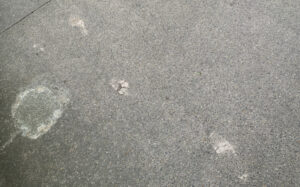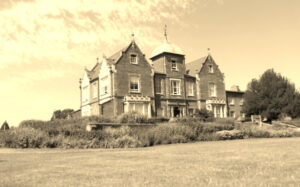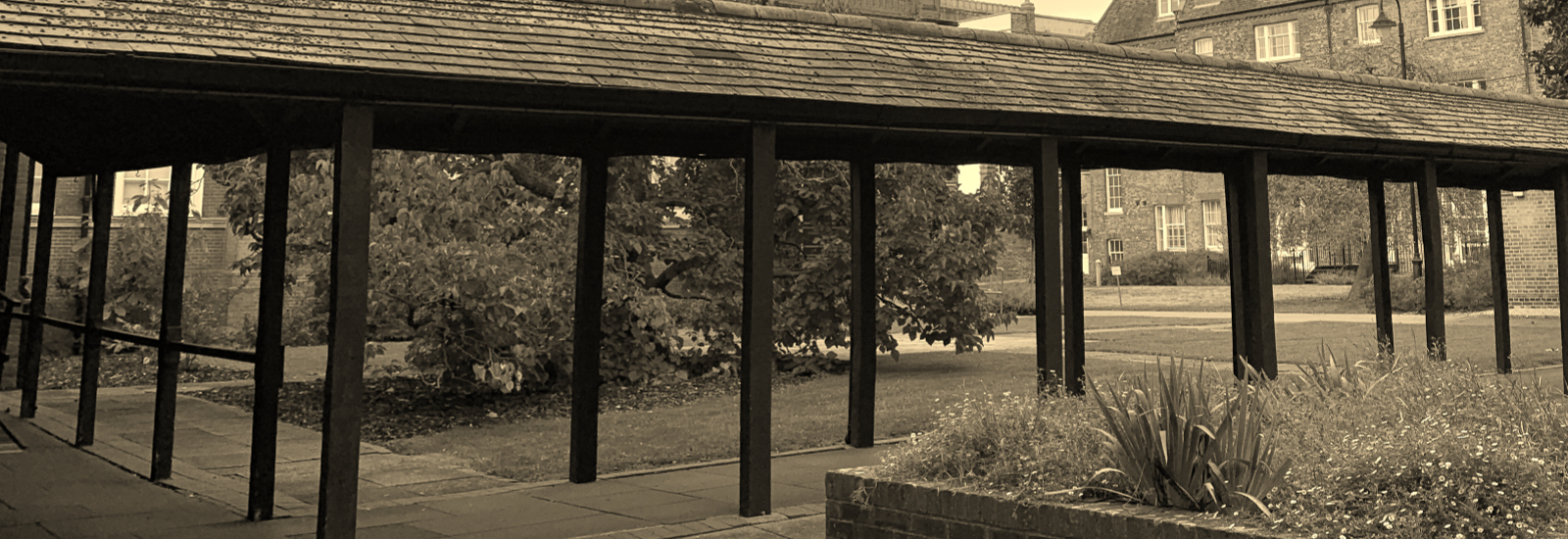This Halloween, we’re diving into the spooky stories of the University of Reading’s Whiteknights and London Road campuses. Are you brave enough to read on…?
The devil’s footprints
Tamesis was the official Reading College, and then University of Reading, magazine, which ran from 1910-73. In the pages of the 1929-30 edition, a devilish story can be found which speculates on a mystery still visible on the London Road Campus today.
Join us on a walk around the old Library on London Road Campus to discover the mystery footprints:
In Tamesis, titled ‘Some New Light on “The Footsteps in the Cloisters”’, it was written:
“This question of the Footsteps in the Cloisters has received little attention of late: few among those who pass them every day realise the importance of finding an explanation of their existence, though many have noticed that they do exist. It is my privilege to open up a new avenue of approach to the subject, for after spending several weeks in close research, I have at last been able to form a theory that fits the facts. …
 The facts of the case are these: along the Cloisters, 13 paces from the library and pointing towards the [Great] Hall, appear 3½ footprints in the concrete. The latest theory (according to certain well known members of the Univ. of Read.) is that they were formed by the soulful British workman who laid the concrete, by reason of a sudden determination to leave his mark on something before he died. But does this fit the case? No, for on a close examination of the footprints we find that they are shaped like a woman’s (though larger) and that the length from one to another is that of a woman’s stride. Moreover, this workman-theory makes no attempt to account either for there being 13 steps along, or the presence of the odd half-step. The other mysterious fact – that the prints remain apparently dry in wet weather – is accounted for, by those who hold this theory, by giving the workman oleaginous [oily] footwear. But I would suggest that this wild and unlikely belief… has no foundation in fact.
The facts of the case are these: along the Cloisters, 13 paces from the library and pointing towards the [Great] Hall, appear 3½ footprints in the concrete. The latest theory (according to certain well known members of the Univ. of Read.) is that they were formed by the soulful British workman who laid the concrete, by reason of a sudden determination to leave his mark on something before he died. But does this fit the case? No, for on a close examination of the footprints we find that they are shaped like a woman’s (though larger) and that the length from one to another is that of a woman’s stride. Moreover, this workman-theory makes no attempt to account either for there being 13 steps along, or the presence of the odd half-step. The other mysterious fact – that the prints remain apparently dry in wet weather – is accounted for, by those who hold this theory, by giving the workman oleaginous [oily] footwear. But I would suggest that this wild and unlikely belief… has no foundation in fact.
These three seem to me to be the significant points: their size, their distance from the library, and their dryness. Are these to be explained by any natural agency? I venture to think that they can not.
…I came to the conclusion that these footprints were made, not by any mortal Britisher, but by the devil, who disguised his hoofs in outsize woman’s shoes (knowing that so he would most easily escape detection);
…that he lived under the Hall…; and that he had flown to the library, to take out books without signing for them, and made these marks in his return flight when he slipped at the 13th step (the weight of the books drawing him heavily to the ground); that he landed on one toe, regained his power after 3 steps and then continued his flight towards the Hall.
The dryness is accounted for by the fact that the devil hates water, so it is reasonable to suppose that anything he has touched will naturally react to it in a mysterious way. …
Another plausible theory, though possibly it is not put forward with the same serious intent, is that they were specially made by the Professor of Philosophy, to promote imaginative effort in the students of his Department. However that may be, the whole question offers a most interesting field of research, and I shall welcome any further contribution to the discussion.”
A workman, the Professor of Philosophy, or the devil? We may never know who made those footprints that are still visible today. The mystery continues.
The woman in the attic
Barrie V. J. Thompson’s work, ‘Whiteknights – A History Of The University Site’ which is held in Special Collections, relays two ghost stories from Whiteknights Campus.
He writes that “In 1931 Miss Eva Teal, 14 years of age, came to Foxhill for interview with the Head Housemaid for the post of Kitchen Maid.” Eva worked at Foxhill under the ownership of Lord and Lady Hirst and shared her ghostly experiences:
 “Eva had relayed her belief that the Park is haunted. “A white lady on a white horse is said to ride through the park on a night in November. She gets to a certain tree and vanishes.
“Eva had relayed her belief that the Park is haunted. “A white lady on a white horse is said to ride through the park on a night in November. She gets to a certain tree and vanishes.
“There was a ghost in old Whiteknights as well” Eva laughed, “I was on the cleaning staff there and we’d all sit perfectly quiet listening, and you’d hear footsteps up in the loft and things being moved about.
On a number of occasions we’ve looked up and seen a woman in the attic windows when we’ve known that nobody was left in the building.
We don’t know who she is, no more than anybody knows why the white lady rides through the park, but she is certainly up there in those attic rooms!”
Eva concludes that perhaps this lady could be the spirit of the Whiteknights Estate, keeping watch as the years go by and new students pass through the University from around the world.
Share your story
Do you remember any spooky tales from your time at the University of Reading? We’d love to hear them! Email us at alumni@reading.ac.uk.
Disclaimer: these stories are based on rumour and not fact.
Sources: Tamesis Vol. XXVIII, No. 2, 1929-30, pp.64-65; Whiteknights: A History Of The University Site, by Barrie V. J. Thompson, pp.89-91. Both held in the University of Reading, Special Collections.




